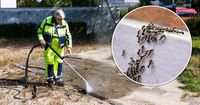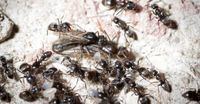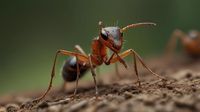Northern Germany is grappling with an unexpected problem: an invasion of an aggressive ant species threatening infrastructure. The ants, known scientifically as Tapinoma magnum, are native to the Mediterranean region and are spreading rapidly, reaching cities such as Cologne and Hanover. According to ant expert Manfred Verhaagh from the Natural History Museum in Karlsruhe, "supercolonies of these ants number from several hundred thousand to millions of individuals," making them significantly larger than colonies of other ant species.
In the city of Kehl, residents have already experienced power outages and disruptions to internet access due to the activities of these invasive ants. The phenomenon is not confined to one area; it has also been observed in Baden-Württemberg, where the invasion poses a serious threat to buildings and technical infrastructure. Local authorities are alarmed as the ants invade homes, creating a potential risk for energy networks and internet connections.
Despite the alarming situation, Tapinoma magnum has not yet been officially classified as an invasive species, primarily due to a lack of sufficient evidence showing a significant threat to local ecosystems. However, Andre Baumann, Secretary of State for the Environment of Baden-Württemberg, considers the species harmful. He noted, "This species is a pest to me, even if it is not legally designated as such." This sentiment reflects growing concerns among experts and local officials.
As experts continue to monitor the situation, they highlight that while Tapinoma magnum does not transmit diseases, there is a possibility that they could cause allergies in humans. The ants are easily recognizable by the characteristic mounds they create on sidewalks and streets. Gregor Koschate from the city administration of Kehl remarked, "They are everywhere," indicating the widespread nature of the infestation.
The invasion of Tapinoma magnum is not limited to Germany. Similar species have also been reported in France and Switzerland, raising concerns about the potential for a broader ecological impact across Europe. As the ants continue to spread, local governments and scientists are collaborating on a project aimed at halting their advance. Measures being taken include using hot water to eradicate the colonies, a tactic that has been employed in various municipalities.
Experts warn that the battle against these invasive ants is challenging, as Tapinoma magnum closely resembles native ant species at first glance. This resemblance complicates identification and eradication efforts. Furthermore, the ants emit a distinctive odor reminiscent of rancid butter, which can be another identifying feature.
In response to the growing crisis, German scientists and authorities have launched a joint initiative to address the invasion. The project aims to assess the extent of the infestation and develop effective strategies for controlling the population of Tapinoma magnum. This collaborative effort underscores the seriousness of the situation and the need for immediate action.
As the situation evolves, residents in affected areas are urged to remain vigilant and report any sightings of the invasive ants. The presence of Tapinoma magnum is becoming increasingly noticeable and problematic, leading to a heightened sense of urgency among local officials and scientists alike.
With the potential for significant disruptions to infrastructure and the risk of allergic reactions among the population, the stakes are high. The invasion of Tapinoma magnum serves as a stark reminder of the challenges posed by invasive species and the importance of proactive measures to protect local ecosystems.
As communities in northern Germany confront this unprecedented challenge, the collaboration between scientists and government officials may prove crucial in mitigating the impact of this invasive ant species. The situation remains fluid, and ongoing monitoring will be essential to understand the full ramifications of the invasion.
In summary, the invasion of Tapinoma magnum in northern Germany is a complex issue that requires immediate attention and action. While the ants have not yet been classified as an invasive species, their rapid spread and potential to disrupt infrastructure have raised alarms among experts and officials. With collaborative efforts underway to control the situation, the hope is to prevent further spread and protect local communities from the challenges posed by these aggressive ants.







